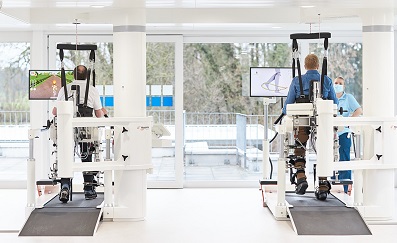World Stroke Day: guidelines recommend using VR and robotics
Hocoma
29th October 2021 marks World Stroke Day, a vital day to raise awareness of the prevention and treatment of the condition, and ensure better care and support for survivors.
About one in four people worldwide will have a stroke in their lifetime, with 50% of stroke survivors left with a degree of physical impairment.
Stroke rehabilitation in the UK
Stroke rehabilitation can be a slow process, beginning at the hospital and continuing in the home. Stroke recovery time varies by the individual and the severity and type of stroke. Slow recovery can result in a longer hospital stay, which can also increase in the risk of complications. Even after leaving the hospital, a substantial amount of support for daily activities may be required by the individual, who may also experience a loss of their independence.
Starting rehabilitation early, and continuing therapy after leaving the hospital, are critical components of recovery. Timely rehabilitation reduces the risk of complications that come from immobility, loss of autonomy, and independence. And with an increasingly ageing population, the demand for physical therapists is not keeping up with supply. As a result, there is less rehabilitation time for stroke survivors.
NICE recommends at least 45 minutes of each relevant stroke rehabilitation at least five days a week, but reports show that patients are not receiving sufficient quantity or quality of care, and that it can be a “postcode lottery” to access services. Read the Right To Rehab report for more findings.
The impact of Covid-19
Covid-19 has made the situation worse, with almost all elements of stroke care and treatment impacted by the pandemic. 39% of stroke survivors who had a stroke this year felt they had not received enough rehabilitation therapies, including physiotherapy. 34% of those who had their stroke in 2019 or before said the support they received from health and care services had been worse than before the pandemic. Around half of all stroke survivors had therapy appointments cancelled or postponed, and 56% have not felt safe to go to scheduled appointments – demonstrating the significant disruption to rehabilitation and support that Covid-19 has caused.
Incorporating robotics into stroke rehabilitation
Filling the gap between what patients need and what clinics and hospitals can offer requires optimising rehabilitation. Effective rehabilitation options, such as virtual reality (VR) and robotic devices, have been made possible by recent scientific breakthroughs and can allow stroke survivors to regain their sense of independence and improve their quality of life.
Guidelines from multiple different countries now recommend the use of robotic therapy as a treatment for stroke survivors. For example, in the UK NICE recommends offering robotic-assisted treadmill training, with or without bodyweight support, to stroke survivors. This helps to build endurance and speed post-stroke.
In this insightful article on Hocoma’s website, you can find an in-depth look at how technology can make a vital difference to a patient’s recovery, including topics such as:
- Robotic therapy is as effective as conventional therapy
- Robotic training can produce better rehabilitation outcomes
- Robot-assisted movement training can be a key part of performing leg exercises for recovery in immobile patients after stroke
- Upper extremity function can be improved with the use of robotic therapy
Robotic and VR rehabilitation can provide consistent and engaging feedback to help stroke survivors comply with rehabilitation therapy. With robotic assistance, rehab time is optimised for faster recovery, which increases the quality of life for stroke survivors. Hocoma’s rehabilitation solutions for arm and hand, gait and balance, strength, and endurance can empower individuals to regain independence faster. Read more on Hocoma’s website.

